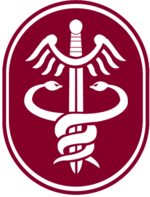National Museum of Health and Medicine
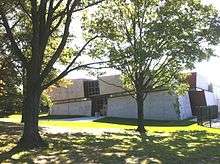 The new NMHM facility, which opened on September 15, 2011. | |
 Location within Maryland | |
| Established | 1862 (new building, 2011) |
|---|---|
| Location | 2500 Linden Lane, Silver Spring, Maryland |
| Coordinates | 39°0′32″N 77°3′14″W / 39.00889°N 77.05389°WCoordinates: 39°0′32″N 77°3′14″W / 39.00889°N 77.05389°W |
| Type | Medicine, Military medicine |
| Visitors | 40,000-50,000 annually |
| Public transit access |
|
| Website |
www |
The National Museum of Health and Medicine (NMHM) is a museum in Silver Spring, Maryland, near Washington, D.C.[1] The museum was founded by U.S. Army Surgeon General William A. Hammond as the Army Medical Museum (AMM) in 1862;[2] it became the NMHM in 1989 and relocated to its present site at the Army's Forest Glen Annex in 2011.[3] An element of the Defense Health Agency[4] (DHA), the NMHM is a member of the National Health Sciences Consortium.[5]
History
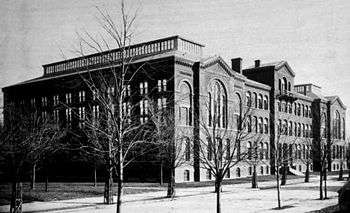
19th century
The AMM was established during the American Civil War[3] as a center for the collection of specimens for research in military medicine and surgery.[6] In 1862, Hammond directed medical officers in the field to collect "specimens of morbid anatomy...together with projectiles and foreign bodies removed" and to forward them to the newly founded museum for study.[6] The AMM's first curator, John H. Brinton, visited mid-Atlantic battlefields and solicited contributions from doctors throughout the Union Army. During and after the war, AMM staff took pictures of wounded soldiers showing effects of gunshot wounds as well as results of amputations and other surgical procedures. The information collected was compiled into six volumes of The Medical and Surgical History of the War of the Rebellion, published between 1870 and 1883.[6]
20th century
During the late 19th and early 20th centuries, AMM staff engaged in various types of medical research. They pioneered in photomicrographic techniques, established a library and cataloging system which later formed the basis for the National Library of Medicine (NLM), and led the AMM into research on infectious diseases while discovering the cause of yellow fever. They contributed to research on vaccinations for typhoid fever, and during World War I, AMM staff were involved in vaccinations and health education campaigns, including major efforts to combat sexually transmissible diseases.[6]
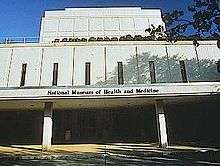
By World War II, research at the AMM focused increasingly on pathology. In 1946 the AMM became a division of the new Army Institute of Pathology (AIP), which became the Armed Forces Institute of Pathology (AFIP) in 1949. The AMM's library and part of its archives were transferred to the National Library of Medicine when that institution was created in 1956. The AMM itself became the Medical Museum of the AFIP in 1949, the Armed Forces Medical Museum in 1974, and finally the NMHM in 1989.[6] During its peak years on the National Mall in the 1960s, every year the Museum saw "as many as 400,000 to 500,000 people coming through". But after its moves to increasingly obscure and out-of-the-way sites, it fell into a period of relative neglect. By the 1990s, it was attracting only between 40,000 and 50,000 visitors a year.[7]
In 1989, C. Everett Koop (in his last year as Surgeon General) commissioned the "National Museum of Health and Medicine Foundation", a private, nonprofit organization to explore avenues for its future development and revitalization, with the aim of ultimately returning its collection to a venue on the National Mall.[8] Proposed was “a site on land that is located east of and adjacent to the Hubert H. Humphrey Building (100 Independence Avenue, Southwest, in the District of Columbia)”.[9] In 1993, a draft bill authored by Sen. Edward Kennedy proposed $21.8 million for moving the existing collection to a new facility to be constructed on that site. That bill, however, was never introduced owing to political difficulties including objections from Constance Breuer—widow of Marcel Breuer, architect of the Humphrey Building—who objected to the view obstruction that would be entailed by the proposed construction. A letter from the Department of Defense to Koop in the mid-1990s, expressed hope that the NMHM exhibits would "one day be provided the appropriate and prominent home they deserve back at the National Mall in the new National Health Museum". But the DoD backed away from contributing to funding a new museum.[10] The Foundation has since been superseded by a new organization, dedicated to creating a new National Health Museum, and which has more ambitious aims and is not dependent on what happens to the existing NMHM.
2011 move
Due to the closure of WRAMC, NMHM has relocated—for the tenth time—to U.S. Army Garrison-Forest Glen in Silver Spring, Montgomery County, Maryland.[11] Authority over the Forest Glen garrison was transferred from WRAMC to Fort Detrick in October 2008. The NMHM closed its exhibits on April 3, 2011, and reopened in a new building on September 15, 2011. On October 1, 2015, the NMHM became part of the Defense Health Agency.[4]
Holdings
Major collections
The NMHM embodies five collections consisting of about 25 million artifacts, including 5,000 skeletal specimens, 8,000 preserved organs,[12] 12,000 items of medical equipment, an archive of historic medical documents, and collections related to neuroanatomy and developmental anatomy. The museum's most famous artifacts relate to President Abraham Lincoln and his assassination on April 14, 1865, by John Wilkes Booth.[13] On display are a copy by sculptor Avarel Fairbanks of Lincoln's life mask and hands made by Leonard Volk in 1860, the bullet fired from the Deringer pistol which ended the President's life, the probe used by the U.S. Army Surgeon General to locate the bullet during autopsy, pieces of Lincoln's hair and skull, and the autopsy surgeon's shirt cuff, stained with Lincoln's blood.[14] In 2010 the heirs of American pathologist Thomas Harvey (1912–2007) transferred all of his holdings constituting the remains of Albert Einstein's brain to the NMHM, including 14 photographs of the whole brain (which is now in fragments) never before revealed to the public.[15][16]
Museum collections include:
- The Historical Collections document changes in medical technology since the early 19th century. Included in this growing assemblage of more than 12,000 objects are x-ray equipment, microscopes, surgical instruments, numismatics and anatomical models.
- The Anatomical Collections are made up of bones and body parts. More than 5,000 skeletal specimens and 10,000 preserved organs document medical cases of disease and injury. The collection supports research in pathology, physical anthropology, forensic anthropology, and paleopathology.
- The Otis Historical Archives houses photographs, illustrations, and documents related to health and medicine. More than 350 different collections document, in pictures and words, the practice of medicine from the Civil War to the present.
- The Human Developmental Anatomy Center maintains the largest collection of embryologic material in the United States. The Center is a primary source for centralized research in developmental anatomy. The Center is also known for its imaging and 3-D reconstructions of embryo development.
- The Neuroanatomical Collections comprise nine different collections focusing on human and non-human neuroanatomy and neuropathology. These collections are a unique international resource for the study of the brain.
Major exhibitions
Museum exhibitions feature several permanent exhibits alongside several rotating displays.
- To Bind Up the Nation's Wounds: Medicine During the Civil War shows Civil War medicine through the eyes of battlefield surgeons and the stories of Union and Confederate sick and wounded.
- Evolution of the Microscope displays items from the world's largest and most representative collection in tracing the development of the basic tool of the bioscientist over the last 400 years.
- Battlefield Surgery 101: From the Civil War to Vietnam, drawn exclusively from the museum's historical archives and historical collections, presents the highlights of the evolution of military surgical activities over the last 140 years through a selection of photographs and 19th- and 20th- century artifacts.
- Abraham Lincoln: The Final Casualty of the War: To mark the 200th anniversary of President Abraham Lincoln's birth, NMHM honors the 16th president of the United States with this exhibition of items associated with his last hours and the physicians who cared for him.
- Trauma Bay II, Balad, Iraq, offers a rare view inside a former Air Force tent hospital in Balad, Iraq.
- RESOLVED: Advances in Forensic Identification of U.S. War Dead highlights the underlying forensic sciences that have evolved in fulfilling this nation’s commitment to the identification and commemoration of the U.S. service member.
Programs offered
The museum offers a wide variety of programs on weekends, weekdays, and evenings throughout the year for adults and children, with topics ranging through a spectrum of medical, scientific, and historical subjects.[17]
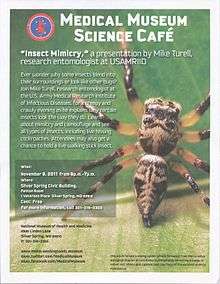
Other exhibit information is available here.
Location and hours
The museum is located at 2500 Linden Lane in Silver Spring, Maryland, one mile outside the District of Columbia. It is open to the public, but security restrictions require a photo ID for all adult visitors.[18] It is open from 10 a.m. to 5:30 p.m. every day except Christmas (when it is closed), and admission is free.[19]
See also
References
- ↑ "Historic Medical Sites in the Washington, DC Area - National Museum of Health and Medicine". nih.gov.
- ↑ "Whonamedit - dictionary of medical eponyms". whonamedit.com.
- 1 2 http://nmhm.washingtondc.museum/about/faq/index.html#2.1
- 1 2 http://www.rttnews.com/2543451/3-us-organizations-set-to-join-defense-health-agency.aspx
- ↑ "National Museum of Health & Medicine - Washington, D.C. - Battlefield Healthcare and Human Anatomy Are Among Themes on Permanent Exhibition at Army Research Center". city-data.com.
- 1 2 3 4 5 http://nmhm.washingtondc.museum/about/about.html
- ↑ Tanouye, Erik, “National Mall Running Out of Space: Federal Planners Want No More Museums in the 2-mile Strip”, Hearst News Service, February 12, 1998.
- ↑ Abse, Nathan, “Push Is On for New Medical Museum as Old Collection Is Modernized”, Washington Post, December 16, 1997.
- ↑ This spot is at Third Street and Independence Avenue SW. See: 108 STAT. 2852 PUBLIC LAW 103-337 —OCT. 5, 1994 (c) RULE OF CONSTRUCTION.
- ↑ Abse (1997), Op. cit.
- ↑ Palk, Justin M. (2008), “Fort Detrick to take over Forest Glen”, FrederickNewsPost.com, 7 October 2008.
- ↑ http://nmhm.washingtondc.museum/about/faq/index.html#5.3
- ↑ http://nmhm.washingtondc.museum/exhibits/nationswounds/lincoln.html
- ↑ http://nmhm.washingtondc.museum/exhibits/exhibits.html#indefinitely
- ↑ Falk, Dean, Frederick E. Lepore, and Adrianne Noe (2012), “The cerebral cortex of Albert Einstein: a description and preliminary analysis of unpublished photographs”, Brain; 135: 11.
- ↑ Balter, Michael, "Rare photos show that Einstein's brain has unusual features", The Washington Post, Tuesday, 27 November 2012; E6.
- ↑ National Museum of Health and Medicine Events, http://nmhm.washingtondc.museum/events/event_2ed.html, accessed 7 Oct 2011.
- ↑ "National Museum of Health and Medicine". Yelp. 28 September 2015.
- ↑ http://nmhm.washingtondc.museum/about/faq/index.html#1.4
External links
- The National Museum of Health and Medicine official website
- BrainMuseum.org - a partnership of the University of Wisconsin and Michigan State Comparative Mammalian Brain Collections and the National Museum of Health and Medicine
- James G. Mundie's photographs from The National Museum of Health and Medicine
- C-SPAN American History TV Tour of the National Museum of Health and Medicine's Civil War Collection
- C-SPAN American History TV Tour of the museum looking at 'Medical History'
